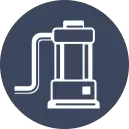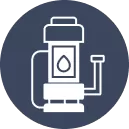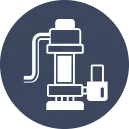Wastewater pumps are mechanical devices that move wastewater liquids containing waste from toilets, sinks, and industrial processes. When wastewater pools in low-lying regions or flat topography, pumps raise the liquid up to sewers, treatment plants or holding tanks. Chosen and maintained correctly, pumps prevent backups, spills, and more general environmental harm.
Types of Wastewater Pumps
There are a variety of pump types used in wastewater systems, so below is a glance at the major ones.
1. Centrifugal Pumps
This type of pump uses a spinning wheel called an impeller. These pumps pull water into the middle of the impeller. It whirls, flinging water peripherally by centrifugal force. They are most effective on thin fluids and small solids. They are easy to use and easy to fix due to their simple design. Typical applications are clear-water lift stations and where wastewater is primarily liquid.
2. Positive Displacement Pumps
Positive displacement pumps trap a specific volume of fluid and displace it into the discharge line. They provide a constant delivery regardless of pressure variation. This makes them perfect for thick polishes and slurries with heavy solids. Examples are diaphragm pumps (which use a flexible membrane), gear pumps (which use rotating gears) or progressive cavity pumps (which use a helical rotor). And these pumps are best for dosing chemicals or moving thick, viscous industrial slurries.
3. Submersible Pumps
Submersible pumps are designed to operate completely submerged in water. The motor and pump are sealed inside a waterproof housing. It also avoids cavitation (air pockets) and dampens noise. These are widely used in sewage basins, sumps, and treatment plants. They can move wastewater directly from deep pits to higher elevations without special enclosures.
4. Grinder Pumps
Another type of water pump is a grinder pump that shreds solids into small pieces before pumping. An internal cutter assembly chops up waste like toilet paper and other solids. The resulting slurry can flow through small-diameter pipes without clogging. These pumps are usually installed in residences or small developments where the main sewer line is located above the property. They help prevent clogs in narrow sewer pipes.
5. Chopper Pumps
Chopper pumps handle tough, fibrous materials that are common in industrial or agricultural wastewater. A heavy-duty cutting mechanism reduces rags, twine, and other hard solids. Once chopped, the material flows easily through the pumping system. Chopper pumps are very effective in plants that treat food waste, animal waste and paper fibers. Their hardened structure is resilient to rough and standard working conditions.
6. Agitator Pumps
The solids can now remain suspended in a fluid without settling due to agitator pumps. They may be equipped with a propeller or stirring device, agitating the wastewater as it pumps. This process keeps grit, sand or organic solids from collecting around the machine. Agitator pumps are commonly used in mining, construction and primary treatment basins at wastewater plants. They provide a homogeneous mixture for a smooth pumping action.
Applications of Wastewater Pumps
Wastewater pumps are used in various applications. They might deal with small household loads or transport millions of gallons in a city system.
- Residential Systems: For homes that are below the level of the sewer, small submersible or grinder pumps send wastewater uphill to the public sewer. They protect basements from back-ups, and they keep plumbing moving.
- Commercial Properties: Pumps help restaurants, hotels and shopping centers manage kitchen waste and restroom discharge. Pumps with higher flow rate sizing help keep bathrooms and kitchens operating during peak flows.
- Industrial Facilities: Factories and processing plants generate wastewater with oils, chemicals, or heavy solids. These types of tough fluids are safely handled by positive displacement or chopper pumps. They stand up to the challenge of corrosive chemicals and sharp debris.
- Municipal Treatment Plants: At sewage treatment plants, large-scale pumps push wastewater through three stages, like screening, clarification, and disinfection. Centrifugal and submersible pumps move flow between tanks, and agitator pumps keep mixed wastewater in aeration basins.
How to Choose the Right Wastewater Pump
The right pump choice will guarantee reliable operation and save money. A few core principles inform the decision:
Wastewater Characteristics
- Determine solids composition, chemistry and viscosity.
- Pump with cutters for tough solids, centrifugal models for clearer water.
Required Flow Rate and Head
- Flow rate (gallons per minute or liters per second) measures the amount of fluid that moves.
- Head (in feet or meters) measures how high the pump needs to lift the wastewater.
- Sizing the pump on a system demand calculation so its performance better matches system requirements.
Material Compatibility
- For pumps that handle acidic or abrasive fluids, choose parts made of stainless steel, cast iron, or corrosion-resistant alloys.
- Proper materials prolong the life of a pump and minimize downtime.
Energy Efficiency
- Seek high-efficiency motor and impeller designs.
- Watt-saving pumps reduce electrical costs over the life of the pump.
Installation Constraints
- Take into account space availability, maintenance access and power supply.
- Because submersible pumps take up less space, they still need to be readily accessible for removal.
Maintenance and Serviceability
- The total pump cost is lowered with replaceable wear parts.
- The availability of spare parts and local service support makes repairs easy.
Maintenance and Troubleshooting
Preventive maintenance ensures pumps are operating optimally and reduces the risk of sudden breakdowns. Basic maintenance guidelines include:
- Routine Inspections: Inspect seals, gaskets, and electrical connections for leaks or damage. Listen for any unusual sounds that might indicate bearing or impeller wear.
- Cleaning: Used to clear dirt, build-up, and foreign bodies from screens and housings. Grinder or chopper pumps must have their cutter assemblies cleaned to ensure cutting efficiency.
- Lubrication: Used to clear dirt, build-up, and foreign bodies from screens and housings. Grinder or chopper pumps must have their cutter assemblies cleaned to ensure cutting efficiency.
- Seal and Bearing Checks: Inspect mechanical seals and bearings for signs of wear. It is essential to replace seals that are worn out to prevent leaks and protect internal components.
As a pump exhibits low flow, excessive starts and stops or won’t start, operators can take simple troubleshooting steps:
- Check Power Supply: Make sure the voltage is correct and the wiring is secure.
- Inspect Impeller and Cutters: Remove any obstructions or debris that can cause the impeller to jam.
- Verify Float Switches or Controls: Ensure sensors and switches are unimpeded.
- Test Motor Windings: Check with a multimeter that the motor windings are intact.
Conclusion
Wastewater pumps are critical to the disposal of wastewater safely and reliably. This category aims to better inform engineers and facility managers about pump types, applications, and selection criteria, ultimately ensuring the best solution is chosen for a particular scenario.
Ongoing maintenance and prompt troubleshooting contribute to long-term performance as well. The right pump and care practices to protect public health, the environment, and operational efficiency.




